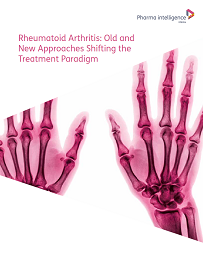Report Library
All Reports
Rheumatoid Arthritis: Old and New Approaches Shifting the Treatment Paradigm
January 26, 2018
Rheumatoid arthritis (RA) is a chronic disease that causes progressive articular damage and results in a wide range of systemic symptoms due to the associated inflammation. Treatment paradigms are well established for RA. Methotrexate, a conventional synthetic disease-modifying antirheumatic drug (csDMARD), is the first-line therapeutic in the US, Japan, and five major EU markets (France, Germany, Italy, Spain, and the UK). Further lines of approved therapeutics are prescribed to DMARD-resistant patients, with the anti-TNFs being the major class of biologics in this space. Other approved biologics (Actemra, Orencia, and Rituxan) that target different immune regulatory pathways are generally prescribed as next-line biologics. More recently, in 2012, a new oral therapy, Pfizer’s Janus protein kinase (JAK) 1/3 inhibitor Xeljanz, was approved, opening the door to a novel therapeutic approach. Despite the many approved RA therapeutics, at least one third of patients remain, or become, unresponsive to treatment. Because of this continued unmet need, and the growing prevalence of RA in an aging population, industry interest in RA drug development remains high. This analysis, using Trialtrove clinical data, explores the recent clinical landscape, with an eye towards highlighting programs seeking durable treatment paradigms, and assessing where the market is heading.
| Indications Covered: | Rheumatoid Arthritis (RA) |
